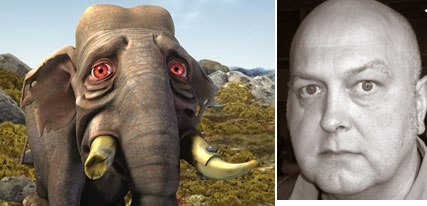Philippe Moins travels to the Annecy Animated Film Festival and finds a lineup of out of the ordinary animation.
It was Free Jimmy, Christopher Nielsen's first feature film that won the Cristal of Annecy festival. The award was well deserved for this out-of-the-ordinary movie with its satirical script and realistic and expressive use of CGI. Presented at the Semaine de la critique during Cannes 2006, Free Jimmy is the first animated feature for the Norwegian movie industry. Co-produced with England, this story about a junkie elephant confronted by lowlifes who lust after him or want to protect him despite his will, was directed by Nielsen, creator of comicbooks and TV shows. He co-wrote the story with Simon Pegg, known as the main actor and the co-writer of the comedy Shaun of the Dead. Pegg lent his voice to the movie, along with Woody Harrelson, Samantha Morton and Kyle MacLachlan.
A Special Distinction was given to The Girl Who Leapt Through Time by Mamoru Hosoda (Japan). This choice confirms the popularity of Japanese animation in Europe, but this popularity is more about Festival preference since DVD sales as the distribution of this kind of movie in theaters is still problematic. Without a doubt, an award from Annecy will have positive effects on the potential success of such a movie. The massive attendance of the Asian societies at the MIFA proves that the European market is the object attention from Asia.
The newly instituted Feature Film Audience Award, went to Max and Co by the Swiss pair Samuel Guillaume and Frederic Guillaume. The audience demonstrated clear-sightedness by its overwhelming support of an old style movie, full of freshness and poetry. Done in stop motion, it benefited from an outstanding chief of animation, Guionne Leroy, a Belgian animator who previously worked for Pixar, Skellington and Aardman. Max and Co is the exact opposite in tone from Free Jimmy. Despite the fact it uses social satire, Max was mainly made for a young audience.
For many years animated feature films were not well represented at Annecy. Even though the competition for feature films was instituted as early as 1985, there seemed to be a lack of interest in recent years. With the passage of time and especially the renaissance of the animated feature film, the long absence of significant animated features and the often-skimpy selections are now hard to imagine.
In a desire to revitalize this part of the festival, CITIA, which manages Annecy sought to reinforce the presence of the animated feature film that better reflects today's film market. From this rebirth, a series of initiatives were developed to emphasize feature films -- the creation of a specific jury for the long form, the creation of two additional prizes (the Special Distinction and the Audience awards), daily presentations, the creation of a section outside of competition, increased number of screenings, etc.
To witness the growth in attendance at MIFA this year, one can say that the new window offered to the animated feature is not totally foreign. No longer do the marketplace and the festival belong to two different worlds. To the marketplace, the TV series reigns as master, but to the festival, there was a never a question of anything but the short film.
The feature film is a central economic issue and an artistic one as well. But, there is a missing link between the needs of business and the artist. A number of directors can legitimately declare that the long form is not adaptable to their artistic style. Can it mean that Annecy will lose its identity, the Festival having been born around the independent short? The Festival's reputation is built on its tremendous and unwavering focus on the independent short. The shorts competition remains at the heart of the Festival and it's important to preserve this aspect of the festival, while returning to a more selective process for features.
The temptation exists, judging from the success of the meetings at the Festival, to emphasize strictly commercial productions that are artistically weak or absent. This year, the competitive section presented nine films as the Festival was striving to keep the number between five and 10. Among these, three, surprisingly, already had been distributed in France. It would be wrong to complain, because these films are among the most interesting and the foreigners who visit the Festival haven't had a chance to seem them in their own countries.
It is the selection outside competition that raises more questions. Why select so many films (16 films, without counting the four premieres)? This makes the feature programming very long and slow. Of course, interesting films were included which shows the innovative spirit and quality of the festival organization. But the presence of some others seems justified by the Festival's need to comply with requests, rather than to promote what CITIA calls, "placement [of work] worthy of an independent production quality."
Thus. appears the dilemma that all festival directors knows well -- how to maintain the balance between the legitimate need to satisfy the spectators, the guiding line of quality that every festival ascribes to, and a certain level of artistic achievement that hovers above it all.
The long form is a tremendous asset for the reputation of the animated movie. It must be treated as such and it will be all the more effective if true artistic creations are allowed to flourish.
Thank you to Oury Atlan for helping to translate.
Philippe Moins is writer and teacher in Belgium, and also co-director of the Brussels Animation Festival ANIMA.










